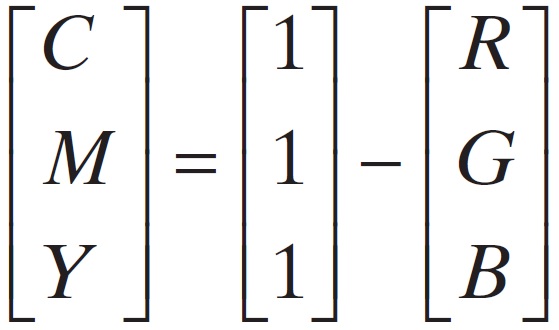CMY and CMYK Color Model
The cyan (C), magenta (M), and yellow (Y) are the secondary colors of light or, alternatively, they are the primary colors of pigments. When a cyan pigment-coated surface is illuminated with white light, no red light is reflected from the surface. In other words, cyan subtracts red light from reflected white light, which is made up of equal parts red, green, and blue light. The majority of devices that deposit colored pigments on paper, such as color printers and copiers, require CMY data input or perform an internal RGB to CMY conversion. A simple operation is used to perform this conversion.

where the assumption is that all RGB color values have been normalized to the range [0, 1]. The above equation demonstrates that light reflected from a surface coated with pure cyan does not contain red (that is, C = 1 - R in the equation). Similarly, pure magenta does not reflect green, and pure yellow does not reflect blue. This equation also reveals that RGB values can be obtained easily from a set of CMY values by subtracting the individual CMY values from 1.
The amounts of the primary pigments, cyan, magenta, and yellow, should result in black. Because C, M, and Y inks are rarely pure colors, combining them for printing black results in a muddy-looking brown. To produce true black (the dominant color in printing), a fourth color, black, denoted by K, is added, giving rise to the CMYK color model. The black is added in exactly the right proportions to produce a true black. As a result, when publishers refer to "four-color printing," they are referring to the three CMY colors plus a portion of black.
The conversion from CMY to CMYK begins by letting
K = min(C, M, Y)
If K = 1, then we have pure black, with no color contributions, from which it follows that
C=0
M=0
Y=0
Otherwise,
C=(C-K)/(1-K)
M=(M-K)/(1-K)
Y=(Y-K)/(1-K)
where all values are assumed to be in the range [0, 1]. The conversions from CMYK back to CMY are:
C=C * (1 - K) + K
M = M* (1-K) + K
Y = Y * (1 -Y) + K
As noted at the beginning of this section, all operations in the preceding equations are performed on a pixel-by-pixel basis. Because we can use the equation  to convert both ways between CMY and RGB, we can use that equation as a “bridge” to convert between RGB and CMYK, and vice versa.
to convert both ways between CMY and RGB, we can use that equation as a “bridge” to convert between RGB and CMYK, and vice versa.